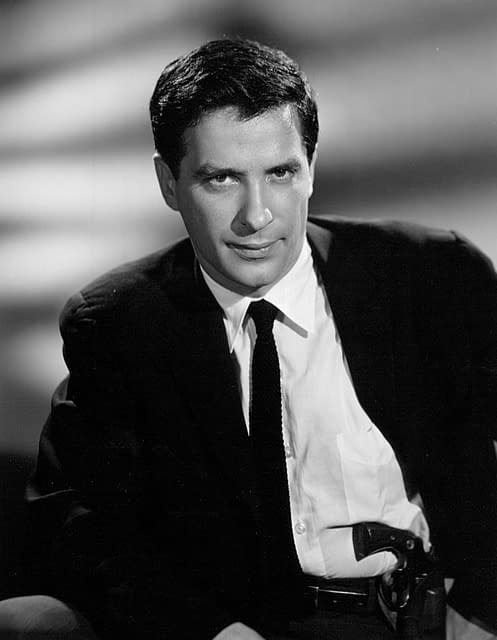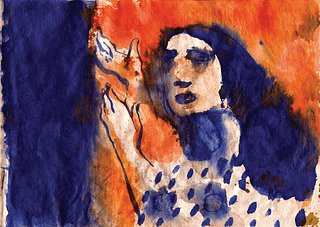
Late one summer night, when even though much diminished the heat of the day hung like a sheet across the dark and desperate sounds of the city, I lay alone in the cool and listened to the actor Ben Gazzara’s voice fill my living room. “The way he worked with amateurs was really a lesson for anyone,” he said. “He wanted them as innocent and unprofessional — a word he hated, by the way — as they could be. And they got looser and looser during the picture, and they got better and better.” Gazzara is talking about his experience working with director John Cassavetes on the 1976 film The Killing of a Chinese Bookie. The interview was conducted in 2004, when Gazzara was seventy-four years old, and he speaks as if the smoke from every cigarette he ever lit remained trapped in his throat. He is wearing a soft wool jumper in pale lilac, and in the latter parts of the interview his eyes sparkle with barely contained tears.
Cassavetes not only hired “amateur” actors for Chinese Bookie, but ensured there was no distinction on set between them and the “professionals” (Gazzara almost spits the word). There was to be no tutelage or hierarchy. Cassavetes wanted something from these non-actors that he felt he couldn’t get from the professionals — something that the professionals, through their training, their experience, their habits, had perhaps lost, or given up. “I think it’s an ingredient that, once you get past the first day, the professional actors feed on that,” said Al Ruban, Cassavetes’ longtime cinematographer and producer. “Not knowing quite what to expect from the other actors. And it makes them sharper, it makes them pay attention more.”
Cassavetes, much like Gazzara, was an actor in everything from low-budget television to major Hollywood productions, and he was known to be an “actor’s director” on his own films. Gazzara talks lovingly of how Cassavetes would work with him — even though he was behind the camera, it felt like he was another actor in the scene. And yet, there is little sense that Cassavetes took acting seriously, at least not in the manner typical of the era, when method acting had become de rigueur. He did not seem to privilege the kind of preparation and immersion which had, since Marlon Brando’s appearance in The Men, communicated for the media and wider public the kind of discipline that elevated an actor from the ordinary to the extraordinary.
This may be a reflection, or even a consequence, of the many roles Cassavetes played in his own productions — actor, director, cinematographer, editor, producer. Someone who must constantly change places cannot possibly be as single-minded as the traditional method actor. The role-switching conversely suggests an approach to filmmaking that is curious, open, and exploratory — anti-specialist and opposed on a fundamental, ethical level to the idea that there is a fixed and established way to go about things. When Gazzara and Ruban talk about the amateur actors on Chinese Bookie — “at some point, not far into each of the films, there’s really no difference, no distinction; they’re all professional,” Ruban says — they are talking about one aspect of an overarching approach to art and life that they, alongside Cassavetes, were engaged in pursuing: there needs to be space for the unexpected, the atypical, the unhabitual. Without some active element that goes somehow against the grain, which interrupts the smoothly competent and unthinking march towards completion, the whole picture is dead.
On YouTube, where I have watched many interviews with Cassavetes and his collaborators over the years, the algorithmic suggestions for other videos I should watch are dominated by a certain type of channel and person. This person is typically not unlike me — typically male, typically aged between twenty-five and forty, typically bearded, typically operating some kind of expensive equipment. Everybody who uses YouTube will have their own version of this person, but for me this person will often be a landscape photographer. I could hardly have less interest in landscape photography as a pursuit but nonetheless, I could name a dozen landscape photographers with small YouTube followings. (There are other professions in my sidebar too: camera gear reviewers, tech tutorials, guitar teachers, furniture makers, people who live in tiny houses in the woods — I am exposing something both intimate and impersonal here.) And I have noticed a pattern: most, if not all, of these unknown landscape photographers will at some point post a video about dealing with burnout and depression. For some reason, these men (and they are all men) are running themselves into the ground — sacrificing ever more time, effort, and money — for the sake of a few thousand views on their video about their solo camping trip in Scotland and a pretty but meaningless photo of a misty mountain lake at sunset. From this distance, it is difficult to understand. What are they chasing?
“There’s little doubt that ‘do what you love’ (DWYL) is now the unofficial work mantra for our time,” wrote Maya Tokumitsu in a widely read Jacobin essay in 2014. The phrase has many permutations and has appeared repeatedly in different settings over the decades, but the surface-level meaning is always the same: if you can make a living out of something you like doing, you will enjoy your life. Tokumitsu asserts that this idea, once completely radical and perhaps even unrecognizable to most industrial-era workers, is now so thoroughly ingrained in the psyche of modern “knowledge workers” that it is unquestioned. Further, doing something you don’t love to make money is likely to be understood as a failure, betrayal even. A tragic frustration of your unique soul and unbounded potential.
The consequences of this are many, and Tokumitsu goes to some lengths in her book, Do What You Love, to detail them. For Tokumitsu the problem is that “it leads not to salvation, but to the devaluation of actual work, including the very work it pretends to elevate — and more importantly, the dehumanization of the vast majority of laborers.” This is undoubtedly true, as many kinds of work that are utterly essential — and many that aren’t socially essential but which are nonetheless necessary for the people engaged in them, because they need to eat and pay rent — can never be framed as “doing what you love.” And to portray the people who hold these jobs (which is to say, basically all people, all jobs) as failures is both reprehensibly inhumane but also a denial of the systemic pressures in place throughout the modern world — life, for most people, is not about individual self-actualization but rather a form of socially-dependent survival. But for our purposes here, the kicker is in the clause: “including the very work it pretends to elevate.” This is an important insight into a key aspect of the modern, tech-lead economy: every career or creative ambition is flattened into a glossy, shallow, unfulfilling nightmare of atomized self-marketing and productivity porn.
My virtual group of depressed landscape photographers epitomize this trend. They are “doing what they love,” and they are doing it in public, for other people; living in the purgatory between the sincere pursuit of an artistic goal and the well-branded self-mythologizing necessary to turn that pursuit into cash via the internet. In fact, YouTube has a name for people like this, people who are something more than hobbyists, something less than professionals; people who are publicly engaged in an artistic activity of some kind, and yet largely disconnected from the history and the established institutions of that activity — creators.
Perhaps the simplest way to define a creator is as a person who, though an artist of a kind, does not derive either their reputation or, in many cases, much of their income from that work; instead, that reputation (and possibly income) flows from turning that original work into content for a social platform — selling the idea of a certain type of life, usually to amateur enthusiasts who may or may not decide to spend large amounts of money on things they almost certainly don’t need based on how well our “creator” can package that life.
Success here is ultimately defined by the whims and algorithms of the platform, and this has been going on for decades, at least as far back as the bloggers and spam-site operators trying to game Google’s search results to generate clicks. In the contemporary version on YouTube, the headline and thumbnail must combine to generate interest, and so these have developed their own aesthetics, conveying both meaning and meta-meaning to the viewer. If you craft it right, the theory goes, people who don’t already watch your videos might click on the thumbnail when exposed to it by the algorithm. Everyone involved knows that consistently “pleasing the algorithm” is the surest way to increase your viewership, much more so than any personal marketing or any effort to improve the quality of your work. And so, because the algorithm is more effective at scale than any personal or social force, the creator is always trapped by the platform, and the freedom promised by “doing what you love” disappears. You, lowly landscape photographer, are left to chase clicks in obscurity, pushing yourself further and further to make more and more spectacular, professional, controversial content for a largely nebulous and unknown audience that can, at any time, be given or taken away by an even more mysterious black box over which you have absolutely no control. (This has arguably become nearly everyone’s fate, no matter the industry.)
Stripped of agency, the contemporary creator cannot reliably or meaningfully engage with others — or even with their own work in many cases. It seems inevitable that they will all eventually make a video about burnout. It comes with the territory.
The story of The Killing of a Chinese Bookie is this: Gazzara plays Cosmo Vitelli, owner of the Crazy Horse West nightclub in Los Angeles, who accrues a gambling debt of $23,000 with the mob. The gangsters put the squeeze on Cosmo, making him sign over his club as collateral, before forcing him to carry out the assassination of the titular Chinese bookie in order to clear the debt.
“Quite frankly I felt really cold about Chinese Bookie at the beginning,” says Gazzara. “I felt that it was not fun. I wasn’t having any fun. It was, eh … too professional.”
In September 1970, John Cassavetes, Ben Gazzara, and Peter Falk appeared on The Dick Cavett Show to promote the film Husbands, which Cassavetes directed and in which all three starred. The picture itself is chaotic, sprawling, and hilarious, but — like most Cassavetes productions — it also possesses a deep melancholy and an almost overwhelming emotional punch. It follows three men, all approaching forty, on a transcontinental bender after the death of a close friend. There is not much of a story, much less plot. It is scene after scene of drunkenness and rambling conversation; if you find the company of the men compelling, you will find the film so — there is nothing else to hold the picture together.
Roger Ebert — the most professional of all film reviewers and therefore a man to be trusted when speaking of mediocrities but almost guaranteed to miss the point when it comes to genius — said that Husbands, “has good intentions, I suppose, but it is an artistic disaster.”
In a LIFE cover story in May 1969, which was reported during the production of Husbands, Falk says the picture is about “three guys who are trying to keep the man-child alive; it’s a sad thing when that kid dies.” The man-child is very much alive in Husbands, though the emphasis is weighted towards the “man” side of the spectrum; the team is most concerned with exploring the prospect of death and what it means to live a well-lived life. But by the time the three men appeared on The Dick Cavett Show the following year, the pendulum had swung laughably far to the childish.
It is difficult even to describe the appearance. Cavett’s introduction sets the scene: “they’re very individual, aggressive, creative, exciting … they’re three animals is what these guys are.” The three men walk out, Gazzara holding a cigar and a glass of whiskey, pushing Falk in the back, Cassavetes whispering in his ear. The sleazy lounge music plays over their awkward handshakes with the host. “Did you call us animals?” says Falk as he sits down. Gazzara immediately interjects, at top volume, still standing, pointing at Cavett: “He’s an animal!” Cavett tries to explain, Cassettes interrupts: “Can I say hello to my mother? … Mom, I want to tell you hello.” Then they say hello “Sunny and the construction crew at Universal.” “Is the bar open backstage?” Cavett asks, beginning to realize what the next forty minutes of live national television was going to look like. They refuse to answer his first question about whether the film was finished. They introduce themselves under the wrong names. They shout at each other, light cigarettes, and talk over Cavett. Cassavetes stands up and pretends to knock himself out cold by hitting his head off the boom mic hovering above the set. All this before the first ad break, roughly three minutes into the show. Their behavior does not necessarily improve as the show goes on.
“I was completely blindsided by it,” Cavett later said. “It was astonishing. I could not believe it, while it was happening.”
Cavett also told how he saw the film’s producer, the aforementioned Al Ruban, give the trio a full-bodied dressing down in the wings after the show. “He got them in a group and said, ‘I really have to congratulate you. You probably unsold more tickets to this movie than most movies get.’”
In short, it is probably the most unprofessional behavior I’ve ever seen on television. And yet, “at the risk of being serious” as Falk says, there are moments of actual insight, moments of connection where the act becomes transparent, and the goofiness reveals something that would otherwise be hidden. They turned this promotional opportunity or obligation into an extension of the film they were there to promote — they kept the spirit of the picture alive against the pressures of the platform used to sell it; they made the appearance, in some blurred and uneasy way, a part of the picture.
“I made a picture that doesn’t have any sentimentality in it but has a great deal of feeling in it”” Falk says, toward the end of the show. “It has the kind of emotions we all experience, but you really don’t see on the screen. The kind of emotions that kind of get lost, because they’re no longer contrived in our film, they’re genuine: delight, hope, irritation, frustration, anger, friendship, love, bewilderment, confusion, they’re all there — go see it.”
Cavett stares into the camera for a second or two, unblinking and unspeaking, looking not a little alarmed. Then, he lifts one hand and says, “What’s new with the loneliest guy in town? Says here let’s watch. We’ll be right back.” They cut to the ad. A professional to the end.
“Films today show only a dream world and have lost touch with the way people really are,” Cassavetes once said. “I have seen people destroy themselves in the smallest way, I’ve seen people withdraw, I’ve seen people hide behind political ideas, behind dope, behind the sexual revolution, behind fascism, behind hypocrisy, and I’ve myself done all these things. So I can understand them. What we are saying is so gentle. It’s gentleness. We have problems, terrible problems, but our problems are human problems.”
I have come to realize that what I love to do is make things. But I am agnostic about the kind of things I make, and so I am not wedded to a single mode of “expression.” I use the word hesitantly because expression — of something innate within me, of some powerful feeling, some idea — is not always, or even often, the end one has in mind when making something. The relentlessly positivist conception of artistic work that dominates today is to me a grossly limited view of what it is to make things, and indeed what it is to live. There is a tendency now in discourse around the arts to ascribe clear meaning to everything, to draw links between what has been made and some convenient and/or faddish sociopolitical framework. But no one would cultivate a rose garden and think, this is my way of directly communicating something about my ancestors’ experience of Soviet pogroms; no one builds a chair to overcome the gender pay-gap. Not everything is about something.
Which is only to say that there is a great part of our existence that is unconnected to history (in the official, annalistic sense of the word) or to politics (in the defanged and spectacularized pseudo-event sense of that word); that we are still, despite the globalized information sewer we now live in, most of the time concerned with ourselves, our immediate environment, and the connections we have to the people we know or have known, and that the best part of what one makes comes as a result of these more intimate, mysterious, and sincere relationships.
It is perhaps understandable that, as the role of the critic has diminished in society (for better or worse, there are no more Eberts), those that remain reach for ever grander statements to confirm their purpose and shore up their tenuous position. Ray Carney, one of the most authoritative voices on Cassavetes’ work and independent American cinema generally, has decried a form of criticism where “authors and their works are treated as more or less direct expressions of the culture that surrounds them.”
Once that conceptual shift has taken place, criticism becomes a form of intellectual history or sociology (only the objects of its attention are different). The seduction of this approach is obvious — which is undoubtedly why it has won so many converts in the past two decades. It offers what seems like an enormous enlargement of the scope and importance of criticism. The critic is no longer a connoisseur of “irrelevant” and superficial aesthetic effects, but is transformed into an analyst of “deep” cultural structures of understanding.
It has been three decades since Carney wrote that, and the diagnosis is as insightful today as ever. In a content-saturated world, where there is no shortage of just causes deserving of attention and moral outrage, the public must be given a reason to care about what the artist has made. And because there is less and less time, less and less space for this act of persuasion within both the traditional media and the eyeball-slicing blackhole of the internet, what the artist is “expressing” must be obvious, immediate, and connected to the hot-button topic of the day. Witness this in the algorithmic recommendations of whatever social media you use; witness it in the aesthetic and linguistic choices of the creators relying on that system.
“He started talking about people that are nuisances, you know? Who kill the dream.”
Gazzara again.
“That gangsters were, in effect, the robbers of people’s souls. And he was telling me that Cosmo, this man, this ordinary man, his dream, his art, was his club, his show, these girls. And these gangsters epitomized all the people, in anyone’s life, who interfere with your dream, who kill it. And I saw that this picture was not a gangster picture at all. This picture was about John. This picture was about the struggle, his struggle, to remain an artist.”
Today, if the artist has any role at all, it may be to claim or reclaim a most intimate and vulnerable space away from the glare of public attention. To avoid exploiting the work, to resist the pressure to capitalize on all aspects of its creation and, more than that, on all facets of one’s being. To deny the great flattening forces of the age.
Away, avoid, deny — the negative thrust of this proposal is clear in its language, but in practice it is nothing more complex than the making of small things, the making of difficult things; useless things, compelling things, honest things; things to remind, things to guide, things to renew; things for ourselves, things for our friends; things to be given away.


